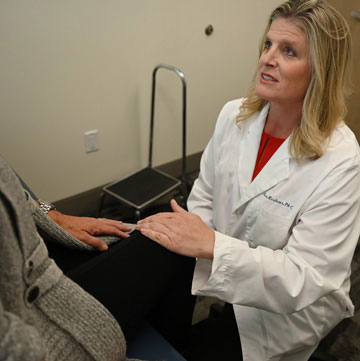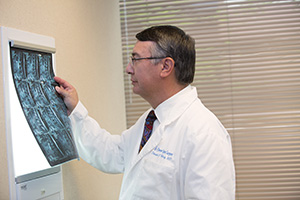Nonsurgical Pain Relief
Return to activity | Diagnostics | Pain relief | Time | Limit rest | Physical therapy | Exercise | Medication | Massage | Biofeedback | Acupuncture
 Return to activity
Return to activity
The three spine physicians at Colorado Spine Partners share the same philosophy in that they emphasize nonsurgical
treatment options in advance of spine
surgery. Non-surgical treatment options are
now provided through a larger network of pain
management specialists and spine therapists.
[Top]
Types of diagnostics you may encounter
- X-rays show bones and the space between bones. Although X-rays are of limited value to muscle-related back pain cases, your physician may conduct X-rays to detect possible fractured vertebrae or narrowing of disc space.
- MRIs (magnetic resonance imaging) and CT scans provide images of soft tissues and nerves in the spine, including discs and joints. This is valuable information to your physician in determining the cause of your pain. These tests provide a medical photograph of your body and are painless.
- Pain-relieving injections can relieve back pain and provide important information about your problem.
- Myelograms can reveal the amount of damage in the spine. They are
used to determine if surgery is necessary. If it is, myelograms provide
a surgeon with key information to ensure the success of surgery.
[Top]
 Pain relief
Pain relief
Doctors who focus mainly on pain symptoms often recommend the exact opposite course of action that is optimal for recovery from a back problem. For example, years ago, doctors treated back pain with bed rest and heavy drugs in order to mask the patient’s discomfort. Patients became sedentary and increasingly dependent on drugs. It was later discovered that this treatment was actually damaging to the back, because it weakened muscles and caused more pain, making recovery more difficult.
Pain is a signal from the body to the brain that something is
wrong. Either a certain motion placed too much strain on the
back, or the back is too weak or inflexible. Your specialist
will help determine the origin of your pain and the best treatment
for it.
[Top]
Give it time
Time is your most valuable asset. In cases where pain is focused in
the low back or when there are no red flag symptoms, take the time to
help yourself. Check out the home remedy section of this Web site for
ways to self-treat your neck and back pain.
[Top]
Limit rest
A study released by The New England Journal of Medicine revealed that the treatment of most back pain cases should involve no more than two days of rest and inactivity. After that, patients should start moving and exercising to strengthen back muscles and increase flexibility. The rehabilitative process requires a commitment on the part of the patient to work closely with a therapist during the first few weeks to ensure a successful long-term recovery.
While drugs and manipulation may relieve initial pain, neither
of these alters the musculature of the back, which is essential
for long-term recovery. Only exercise can strengthen the back muscles
and make them more flexible and resistant to future strain.
[Top]
Physical therapy
Physical therapy increases flexibility and strengthens muscles that
support the spine. Greater strength and flexibility will help prevent
future back strain. A therapist may use ultrasound, electrical stimulation,
heat or ice, mobilization and exercises to reduce pain and get you back
to activity. Click here to learn more about physical therapy.
Exercise
Years ago, the prescription for pain was bed rest. However, we know today that more than a few days of bed rest after an injury can be counterproductive to rehabilitation. Exercise and movement actually help tissues in the back become stronger, more supportive of the back and resistant to further injury. Specific exercises can be used to target particular types of back pain. Engaging in activity acts as a lubricant to the back muscles and joints, and it’s as necessary to recovery as oil is to the hinge in a squeaky door.
For most back or neck pain sufferers, exercise is the last thing you would want to do. Years ago, however, a New Zealand physical therapist named Robin McKenzie noticed that some of his patients with herniated discs experienced relief of pain symptoms simply by bending over and extending. Since then, McKenzie flexion and extension exercises have been used by back pain clinics around the world to help people recover from back and neck pain without surgery. Here’s how these exercises work.
The back is composed of vertebrae which are separated by soft discs that act as shock absorbers. These discs resemble jelly donuts because of their jelly-like center. In some cases, the wall of the disc ruptures, causing the center of the disc to herniate outward. This places painful pressure on the nearby nerves that branch off from the spinal cord. Many herniations occur at the back of the disc wall. Special extension exercises in which the back arches backward can compress the back side of the disc, which creates a vacuum toward the front of the disc. This vacuum can suck the herniation back inward, thereby relieving pressure on the adjacent nerve root. While the disc herniation has not been fixed, the pain generated by the herniated disc may be lessened.
 It is important to work with a therapist to make sure exercises are
done properly. When doing exercises, don't hold your breath. Breathe
normally. Move slowly when you stretch. Never bounce or jerk abruptly.
Never do any exercise that causes pain to your back. Just as it took
years for you to become less flexible, it will take months of stretching
to restore flexibility.
It is important to work with a therapist to make sure exercises are
done properly. When doing exercises, don't hold your breath. Breathe
normally. Move slowly when you stretch. Never bounce or jerk abruptly.
Never do any exercise that causes pain to your back. Just as it took
years for you to become less flexible, it will take months of stretching
to restore flexibility.
Back exercises can be done several times a day as needed. Some of the standing exercises can be done at work. If you have to sit at a desk a lot during the day, take a break every hour and stand, move around and do stretches to help out your back. Walk up or down stairs rather than taking the elevator.
Medication
Medications can reduce swelling and pain in the back and neck. The type of medication your physician recommends depends on your symptoms and your level of pain.
At home, pain can be relieved with non-steroidal anti-inflammatory
drugs (NSAID), such as ibuprofen products like Motrin or Advil.
Aspirin may also be recommended to ease pain.
[Top]

Massage
Not only is massage relaxing but it also has notable health benefits that are an important part of back rehabilitation. Massages release toxins in muscles, increasing circulation, releasing endorphins, reducing inflammation, alleviating muscle cramps, breaking down scar tissue and calming the nervous system.
Aside from its physical health benefits, massage has a psychological
impact by teaching the patient to feel relaxed. For the chronic back
pain sufferer, even the simple luxury of drifting off to sleep may not
be a reality. Massage can provide that feeling of calm.
[Top]
Biofeedback
For thousands of years, Eastern medicine has emphasized the importance of the mind in controlling physical health. In the West, these ideas were touted as mystical and scientifically unfounded. Recently, however, as more scientific connections are being made between mind-body healing, Western science is starting to appreciate and incorporate this type of therapy into pain rehabilitation.
Due to its objective means in tracking progress, biofeedback is one of the more popular mind-body therapies in pain rehabilitation. During biofeedback sessions, electrodes are attached to the body to monitor body temperature, heart rate, muscle tension, skin resistance and perspiration.
Through biofeedback, the patient is taught to recognize how stress and relaxation chemically alters the body's functions. The patient can learn to lower heart rate and muscle tension. The biofeedback equipment records statistics and gauges progress as the patient learns to control the body, thus controlling pain.
After recognizing the body’s signals during
biofeedback sessions, the patient is able to recognize them in daily
life and arrest the onset of muscle spasms or high blood pressure.
This can reduce pain and even eliminate it.
[Top]
Acupuncture
Traditional acupuncture is based on the ancient Chinese theory that there are energy pathways that run throughout the body. These pathways, called meridians, carry the body's vital energy, or chi (pronounced "chee"). The principle behind acupuncture is that disease and pain are a result of an imbalance in the body's energy flow (chi). Through the insertion of thin needles at specific points along meridians, the flow of energy is controlled and rebalanced in the body.
Acupuncture dates back to the first century B.C. in China, during the era of the Han dynasty (206 B.C.-220 A.D.). Because Western physicians in the United States have difficulty understanding the correlation between acupuncture philosophies and traditional physiology, acupuncture has not been readily accepted in the United States.
Modern scientists have attempted to explain how acupuncture can relieve pain. Some observe that the traditional Chinese "meridians" overlap with pathways of the central nervous system. By using needles, an acupuncturist can stimulate the nervous system to release endorphins (morphine-like chemicals) in the muscles, spinal cord and brain. These chemicals either relieve pain symptoms or trigger other chain reactions that relieve them.
Acupuncture is nonsurgical, does not involve drugs, and has no extremely
negative side effects or permanent complications. It may be worth exploring
as a nonsurgical option, particularly if you have exhausted the traditional
remedies of Western medicine.
